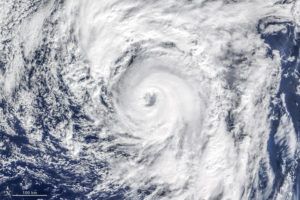There’s something a little off about Alex.
The hurricane developed in the Atlantic Ocean in January, getting the 2016 storm season, which officially began June 1, off to an early start. Or did it?
“One could make the case that extremely early tropical cyclones such as Alex are more closely tied to the previous year’s activity,” Bob Henson, a Weather Underground meteorologist, wrote in his blog last week.
Alex was the earliest hurricane to form in the Atlantic since 1938 – with an asterisk: In 1955, Hurricane Alice was alive and well in January, but it was a holdover from December 1954, according to NASA.
The reason Alex, as well as other storms, could be counted in the previous year is that the Atlantic doesn’t recognize our human calendars. In the Northern Hemisphere, the ocean’s seasonal cooling and warming cycle runs more or less from March to February, Henson said. So Alex began in the tail end of the cycle.
Following Calendar
However, global meteorologists have a nice list of storm names in alphabetical order, divided by year, for the Atlantic and eastern Pacific. So, a system in 2016 had to get the name Alex.
While it may not sound like much, that one name can change the complexion of a season. If Alex is added to last year’s storm count, then it was an average year in terms of overall named storms. Without it, 2015 was a below-average year.

With Alex as a 2016 storm, this season marks the earliest a “C” storm has formed in the Atlantic since these systems started getting names in the 1950s, Henson wrote in his blog. Bonnie formed in May and Colin formed in June.
If you eliminate Alex, then two storms formed near the start of this year’s season. This has happened before; in 2012, for instance, tropical storms Alberto and Beryl developed before June 1.
The annual count aside, does any of this pose a long-term record-keeping problem?
‘Occasional Annoyance’
Not really, said Phil Klotzbach, lead author of the Colorado State University seasonal forecast. January storms are 1-in-10-year, or even 1-in-20-year, events, so at best they represent “an occasional annoyance.”
“I would personally probably count it as last year, due to the occasional storm that goes from December to January, but for sake of clarity it’s easier just to include it with 2016’s numbers,” Klotzbach said.
This is the conclusion Henson reached, as well. The potential is for public confusion is too high, and the world is “committed to the calendar-year naming approach,” he said.
And besides, the whole thing can be cleared up with an asterisk and a footnote.
Was this article valuable?
Here are more articles you may enjoy.

 Senate Says Climate Is Driving Insurance Non-renewals; Industry Strikes Back
Senate Says Climate Is Driving Insurance Non-renewals; Industry Strikes Back  Cargo Theft Surges as Holiday Season Approaches, Verisk Says
Cargo Theft Surges as Holiday Season Approaches, Verisk Says  Mississippi High Court Tells USAA to Pay up in Hurricane Katrina Bad-Faith Claim
Mississippi High Court Tells USAA to Pay up in Hurricane Katrina Bad-Faith Claim  Congo Sues Apple Alleging ‘Pillaged’ Minerals in Products
Congo Sues Apple Alleging ‘Pillaged’ Minerals in Products 